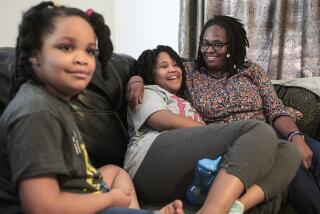Researchers debunk the idea that asthma is more common in inner cities

- Share via
For more than 50 years, the conventional wisdom about asthma has been that it thrives in poor, densely populated urban areas. Researchers have even gone so far as to declare an “inner-city asthma epidemic.” But they’ve never actually checked whether asthma is more common in city centers than in suburbs or rural areas.
Until now.
A study published this week in the Journal of Allergy and Clinical Immunology compared asthma rates among children in census tracts across the country and found that kids in inner-city neighborhoods were no more likely to have asthma than kids who live elsewhere.
Asthma is a a lung disease that affects more than 25 million Americans, including about 7 million children, according to the National Heart, Lung and Blood Institute. These people have inflamed airways that are prone to swelling, which makes it very difficult to breathe. In extreme cases, an asthma attack can be fatal.
People living in poor urban areas may be particularly susceptible to asthma for a variety of environmental and cultural reasons. Indoor allergens from rodents and cockroaches can trigger an attack, as can pollutants like cigarette smoke and particles from diesel exhaust. Being poor is also associated with worse diets, more stress and less breast-feeding – all risk factors for asthma.
Researchers from Johns Hopkins University used data from the National Health Interview Survey to gauge the prevalence of asthma in city centers and compare the results to that of suburban and rural areas. The NHIS is conducted by the Centers for Disease Control and Prevention and includes questions about whether subjects have ever been diagnosed with asthma, whether they’ve had an asthma attack in the past year, and whether any recent attacks have been bad enough to send them to a hospital emergency room. The researchers focused on data from 23,065 children between ages 6 and 17 who were interviewed between 2009 and 2011.
Their first pass at the data revealed that 12.9% of children who lived in inner-city neighborhoods had asthma, compared with 10.9% of children who lived in all other kinds of neighborhoods. But when the researchers factored in things like the children’s race and ethnicity, gender, age and the region of the country where they lived, the gap between inner-city and non-inner-city asthma rates became too small to be statistically significant, according to the study.
“There were no differences in asthma prevalence in suburban, small-town, and rural neighborhoods compared with urban neighborhoods,” the researchers wrote, debunking widely held beliefs to the contrary.
Asthma prevalence within city centers varied widely in different parts of the country. In the West, for instance, only 7.9% of inner-city children had asthma, while in the Northeast that figure was 17.3%.
In fact, the researchers found that medium-sized cities in the Northeast and Midwest along with suburban neighborhoods in the Northeast had higher asthma prevalence than inner-city neighborhoods in any part of the country. A child’s neighborhood type didn’t matter so much as his or her racial, ethnic and socioeconomic factors.
Puerto Rican children had the highest prevalence of asthma (19.8%) among all the racial and ethnic groups in the study, followed by African American children (17.1%). The lowest prevalence was seen among Asian American children (8.1%), non-Puerto Rican Latino children (8.8%) and white children (9.6%).
Only three factors were linked with a higher risk of a recent asthma attack and a recent ER visit: African American or Puerto Rican ancestry and a low household income. But children with these backgrounds live all over the country – not just in inner cities, the researchers wrote.
“In recent years, the fastest growth in high-poverty areas has occurred in suburban and smaller metropolitan areas,” they wrote. “The suburbanization of poverty means that despite continued high rates of concentrated poverty in cities, there are now more poor people living in suburban than urban communities.”
For more health news, follow me on Twitter @LATkarenkaplan and “like” Los Angeles Times Science & Health on Facebook.






